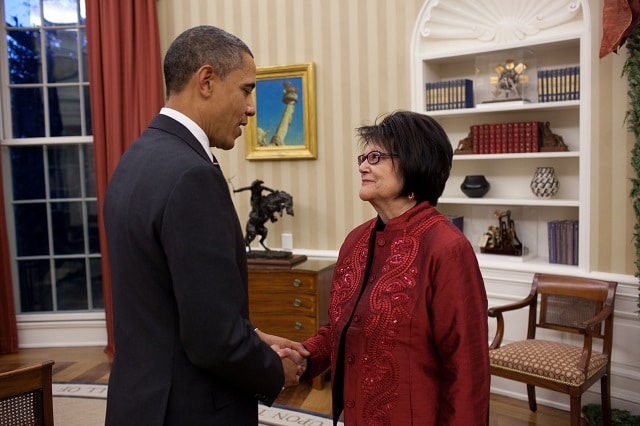By Tesia Zientek, CPN Education Director

For Native Americans, the Cobell v. Salazar landmark class-action case was historic. Some of you understand the case in painful detail because you or your family was affected. Others may only be familiar with it because of the ubiquitous memes joking about incoming Cobell checks. Still others have no idea who or what I’m talking about.
Just in case, here’s a quick refresher. After tribal lands were ruthlessly sliced into allotments in the 1880s, the United States government held over 54 million acres of allotted land in trust for the benefit of individual Native Americans. Income from government sale and lease of those lands and their extremely profitable natural resources—think oil, natural gas, timber, coal—was to be deposited into the U.S. Treasury General Account, held in the Individual Indian Money Trust, invested in common, and ultimately paid out to the beneficiaries of the IIM Trust.
Spoiler alert: that’s not what happened. Unfortunately, and perhaps not to the surprise of many cynics, what the government promised and what it actually did were two entirely different things. Instead of payments going out to the Native American beneficiaries, the money was used to do things like reduce the national debt. Beyond this egregious mishandling, the government also made an attempt to cover their tracks by destroying most of the IIM Trust records.
In 1996, Elouise Cobell, a member of the Blackfeet Tribe, brought a class-action suit in hopes of forcing the United States to perform a full historical accounting of all IIM Trust funds, to correct and restate IIM account balances, to fix broken trust management systems and to implement reform measures to ensure that this kind of exploitation did not happen again. After 16 years of hearings, trials, and appeals, an unprecedented $3.4 billion settlement was reached in December 2009. This was a huge win for Cobell, the 500,000 class action lawsuit members she spoke for, and all of Indian Country.
So, what does all of this have to do with the Education Department? Among other things, the settlement authorized the Cobell Education Scholarship Fund, which aims to provide financial assistance to Native American students pursuing post-secondary education and training. The fund is partially funded by the Land Buy-Back Program for Tribal Nations. As of January 2016, the buy-back program has transferred nearly $35 million to the Cobell Education Scholarship Fund.
As Native Americans, all Citizen Potawatomi Nation tribal members who are pursuing post-secondary (after high school) education and can demonstrate an unmet need are eligible to apply for this scholarship. For the 2016 summer term, the May 1, 2016 deadline has passed. For the 2016–17 academic year, applications are due June 1, 2016. Award amounts vary based on unmet need. Students can find the application and more details at http://cobellscholar.org.
With all of this in mind, I have a challenge for our college-bound Citizen Potawatomi Nation students. First, read more about the Cobell lawsuit at the website above. I’ve given only a superficial overview here, and it deserves a deeper look because it’s an important part of our recent history as Native Americans. Second, apply for the Cobell Scholarship. According to the published records, only one Citizen Potawatomi Nation tribal member received a Cobell scholarship last academic year. I know from talking to several of you that there are more who desperately need this financial aid. As a tribe, let’s not leave this money on the table. We can do better by Ms. Cobell, who fought tirelessly to ensure a better future for our young people.
As always, please do not hesitate to reach out to the CPN Education Department at college@potawatomi.org or 405-275-3121.
